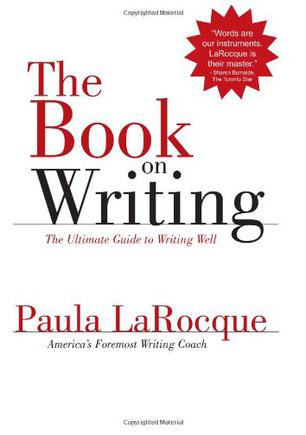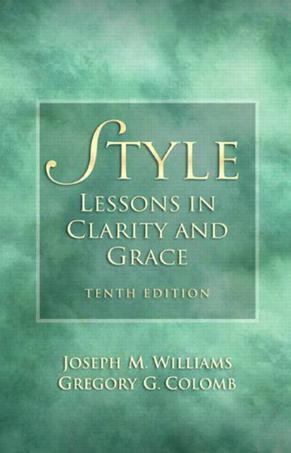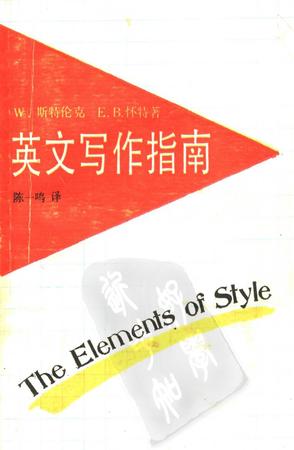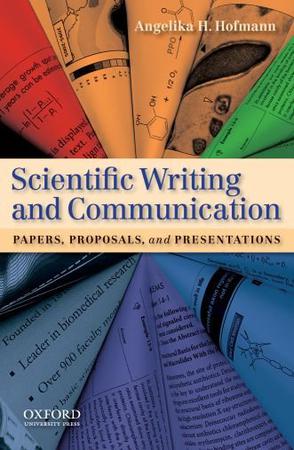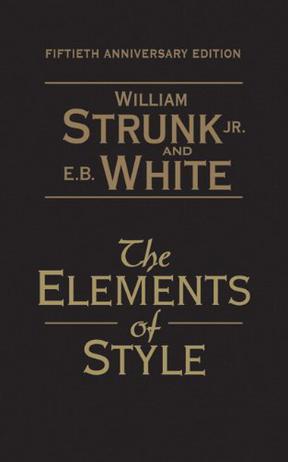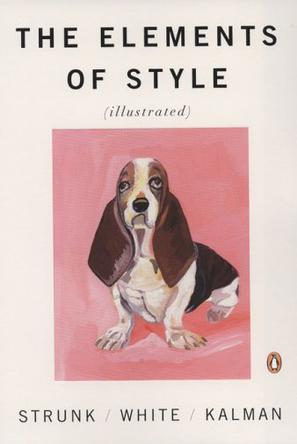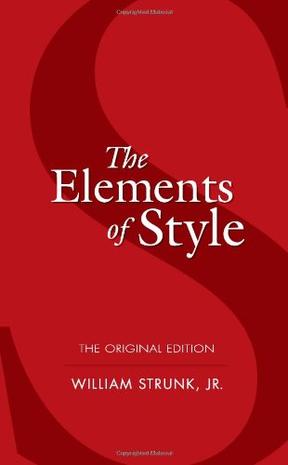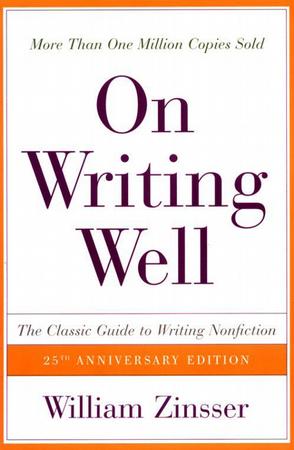欢迎来到相识电子书!
标签:英文写作
-
The Book on Writing
Many books attempt to teach the elements of good non-fiction writing, but only one does it in the gentle, humorous way of famous writing coach Paula LaRocque. LaRocque's new book is the result of a lifetime spent as a journalist and writing educator. This book contains 25 chapters in three sections. The first section spells out a dozen essential guidelines to good writing, from the importance of short sentences to the value of using a conversational tone. Section Two teaches the reader how to tell a story -- how to build suspense, how to effectively describe things, how to use literary devices. Section Three is a concise handbook on writing mechanics, such as grammar, usage, punctuation and style. Each section is loaded with illustrative examples of great non-fiction writing, and LaRocque's gentle humour makes reading a pleasure. This is LaRocque's gift to the writing world -- it is destined to become a classic. -
Style
Engaging and direct, Style: Lessons in Clarity and Grace is the guidebook for anyone who wants to write well.Engaging and direct, Style: Lessons in Clarity and Grace is the guidebook for anyone who wants to write well. -
英文写作指南
本书介绍了英文写作中的诸多问题。如:惯用法的基本原则、常误用的词与词组、写作的基本原则、文体初探等。 -
Scientific Writing and Communication
Scientific Writing and Communication: Papers, Proposals, and Presentations covers all the areas of scientific communication that a scientist needs to know and to master to successfully promote his or her research and career. This unique "all-in-one" handbook begins with a discussion of the basics of scientific writing style and composition and then applies these principles to writing research papers, review articles, grant proposals, research statements, and resumes as well as to preparing academic presentations and posters. FEATURES: A practical presentation carefully introduces such basic writing mechanics as word choice and word location, sentence structure, and paragraph organization before moving into manuscript planning and organizational strategies. Extensive hands-on guidance for composing scientific documents and presentations then follows. Relevant and multi-disciplinary examples taken from real research papers and grant proposals by writers ranging from students to Nobel Laureates illustrate clear technical writing as well as common mistakes that one should avoid. Examples are drawn from a broad range of scientific disciplines including medicine, molecular biology, biochemistry, ecology, geology, chemistry, engineering, and physics. Extensive end-of-chapter exercise sets provide the opportunity to review style and composition principles and encourage readers to apply them to their own writing. Writing guidelines and revision checklists warn scientists against common pitfalls and equip them with the most successful techniques to revise a scientific paper, review article, or grant proposal. Annotated text passages bring the writing principles and guidelines to life by applying them to real-world, relevant, and multidisciplinary examples. Clear, easy-to-follow writing style is understandable to both native and non-native English speakers; special ESL features address problems faced by non-native English speakers. Eight chapters on grant writing demonstrate how to write successful grant applications and how to avoid the most common application mistakes. Covering all the facets of communication that scientists need to master, Scientific Writing and Communication: Papers, Proposals, and Presentations is ideal for a wide range of readers--from upper-level undergraduates and graduate students to postdoctoral fellows, faculty, and professional researchers--in the life sciences, medicine, psychology, chemistry, and engineering. -
The Elements of Style
You know the authors’ names. You recognize the title. You've probably used this book yourself. And now The Elements of Style –the most widely read and employed English style manual–is available in a specially bound 50th Anniversary Edition that offers the title's vast audience an opportunity to own a more durable and elegantly bound edition of this time-tested classic. Offering the same content as the Fourth Edition, revised in 1999, the new casebound 50th Anniversary Edition includes a brief overview of the book's illustrious history. Used extensively by individual writers as well as high school and college students of writing, it has conveyed the principles of English style to millions of readers. This new deluxe edition makes the perfect gift for writers of any age and ability level. Fifty Years of Acclaim for The Elements of Style , by William Strunk Jr. and E.B. White I first read Elements of Style during the summer before I went off to Exeter, and I still direct my students at Harvard to their definition about the difference between 'that' and 'which.' It is the Bible for good, clear writing.”-- Henry Louis Gates Jr. “For writers of all kinds and sizes the world begins and ends with Strunk and White’s Elements of Style . Only something to actually write abouttrumps the list of what is required to put words together in some kind of coherent way. I treasure its presence in my life and salute its fifty years of glory and accomplishment."-- Jim Lehrer “ The Elements of Style remains an unwavering beacon of light in these grammatically troubled times. I would be lost without it.” -- Ann Patchett "To the extent I know how to write clearly at all, I probably taught myself while I was teaching others -- seventh graders, in Flint, Michigan, in 1967. I taughtthem witha copy of Strunk & White lying in full view on my desk, sort of in the way the Gideons leave Bibles in cheap hotel rooms, as a way of saying to the hapless inhabitant: ‘In case your reckless ways should strand you here, there's help.’ S&W doesn't really teach you how to write, it just tantalizingly reminds you that there's an orderly wayto go about it, that clarity's ever your ideal, but -- really -- it's all going to be up to you." -- RichardFord “ The Elements of Style never seems to go out of date. Its counsel is sound and funny, wise and unpretentious. And while its precepts are a foundation of direct communication, Strunk and White do not insist on a way of writing beyond clear expression. The rest is up to the imagination, the intelligence within.” -- David Remnick, editor of The New Yorker “It’s the toughness–the irreverence and implicit laughter–that attracted me to the little book when I was seventeen. I fell in love with Strunk & White’s loathing for cant and bloviation, the ruthless cutting of crap, jargon, and extra words. For me, that skeptical directness included a tacit permission by The Elements of Style to break its rules on occasion: an alloy of generosity in the blade, a grace I still admire and still learn from.” -- Robert Pinsky “In the quest for clarity, one can have no better guides than Strunk and White. For me, their book has been invaluable and remains essential.” -- Dan Rather "Eschew surplusage! A perfect book."--Jonathan Lethem "Not until I started teaching writing and I reread The Elements of Style did I realize that most everything I would be teaching young writers, and everything I would be learning myself as a writer, was contained between the covers of this slim, elegant, wise little book. -- Julia Alvarez “Strunk and White seared their way into my brain long ago, and I benefit from them daily.” -- Steven J. Dubner, co-author of Freakonomics “Since high school, I have kept a copy of this book handy. That should be unnecessary. I should, by now, have fully internalized The Elements of Style . But sometimes I get entangled in a paragraph that refuses to be ‘clear, brief, bold.’ I dip back into The Elements of Style and am refreshed. After Scott Simon interviewed me on NPR about whether the word ‘e-mail’ needs a hyphen (yes, it does), some listeners, including friends of mine, wondered why I had answered in the affirmative when asked, in passing, ‘Are you a drunken white man?’ Those listeners misheard. ‘Strunk and White man’ was what Scott said.” -- Roy Blount Jr. “Strunk & White--writing's good-natured law firm--still contains enough sparkling good sense to clean up the whole bloviating blogosphere." -- Thomas Mallon “I used Strunk -- that’s what we called it, Strunk -- as a student at Berkeley fifty years ago. I didn't know that it was new, and that we were the first generation to be educated in The Elements of Style . I got a firm foundation in the English language, learned to write basically, and could depict the realistic world.Then I was able to become an impressionist and expressionist.” -- Maxine Hong Kingston “Strunk and White's gigantic little book must be the most readable advice on writing ever written. Side by side with Roget, Shakespeare, the Bible, and adictionary, it's an essential forevery writer's shelf.” -- X.J. Kennedy... 美国大学校园人手一册的英语语法书籍。 -
The Elements of Style
The only style manual ever to appear on bestseller lists has explained to millions of readers the basic principles of plain English. The book's mantra-make every word tell-is still on point. Whether seventeen or seventy, this much-loved classic, now in its fourth edition, will forever be the go-to guide when in need of a hint on how to make a turn of phrase clearer, or a reminder on how to enliven prose with the active voice. Kalman's exquisite illustrations give the revered work a jolt of new energy, making the learning experience more colorful and clear. The Elements of Style Illustrated will come to be known as the definitive, must-have edition. -
The Elements of Style
This classic reference is a must-have for any student or writer. In this brief handbook, Strunk identifies the principal requirements of proper American English style and concentrates on the most often violated rules of composition. Authoritative and engagingly written, this is simply the greatest book of its kind. -
观念的生成
写作必以观念或思想为先导,这是一条不变的法则。对于批判性思维的培养和高级写作能力的提升就更为如此。《观念的生成:主题写作读本》就是一本为达此目的而编撰的英美大学一年级写作课教材,在中国适用于英语专业本科高年级阅读和写作课。所谓“观念的生成”,说的是作文中所要表达的思想,大致要回答下面这些“说来容易写起来难”的问题:思想从哪儿来?是关于什么的?该如何表达?怎么去总结和评价?本书通过理解、生成、扩展和应用思想这四个步骤来提高学生的批判性思维能力和写作能力。理解就是理解所读文本的特殊观点;生成就是通过这种理解性阅读让学生提出自己的观点;扩展就是扩展文本的语境,使其与其他相关文本联系起来,扩大思考的幅度;应用就是在这三个步骤之后让学生将理解、生成和扩展的思想用于自己的写作实践。全书共分八章,除第一章总序外,其他七章汇集的文章中都就大学生所敏感的问题进行了热烈的讨论:年轻人的反叛精神,成长的烦恼,个人主义、孤独和异化,大学生的身份,金钱、社会阶级和自我,个人的权利以及梦想或理想等。所有文本不但思想性强,而且语言精湛,都是名家名篇。学生既能在无垠的思想海洋里畅游,又能在增进思考能力的同时学到隽美的语言。
热门标签
下载排行榜
- 1 梦的解析:最佳译本
- 2 李鸿章全传
- 3 淡定的智慧
- 4 心理操控术
- 5 哈佛口才课
- 6 俗世奇人
- 7 日瓦戈医生
- 8 笑死你的逻辑学
- 9 历史老师没教过的历史
- 10 1分钟和陌生人成为朋友

